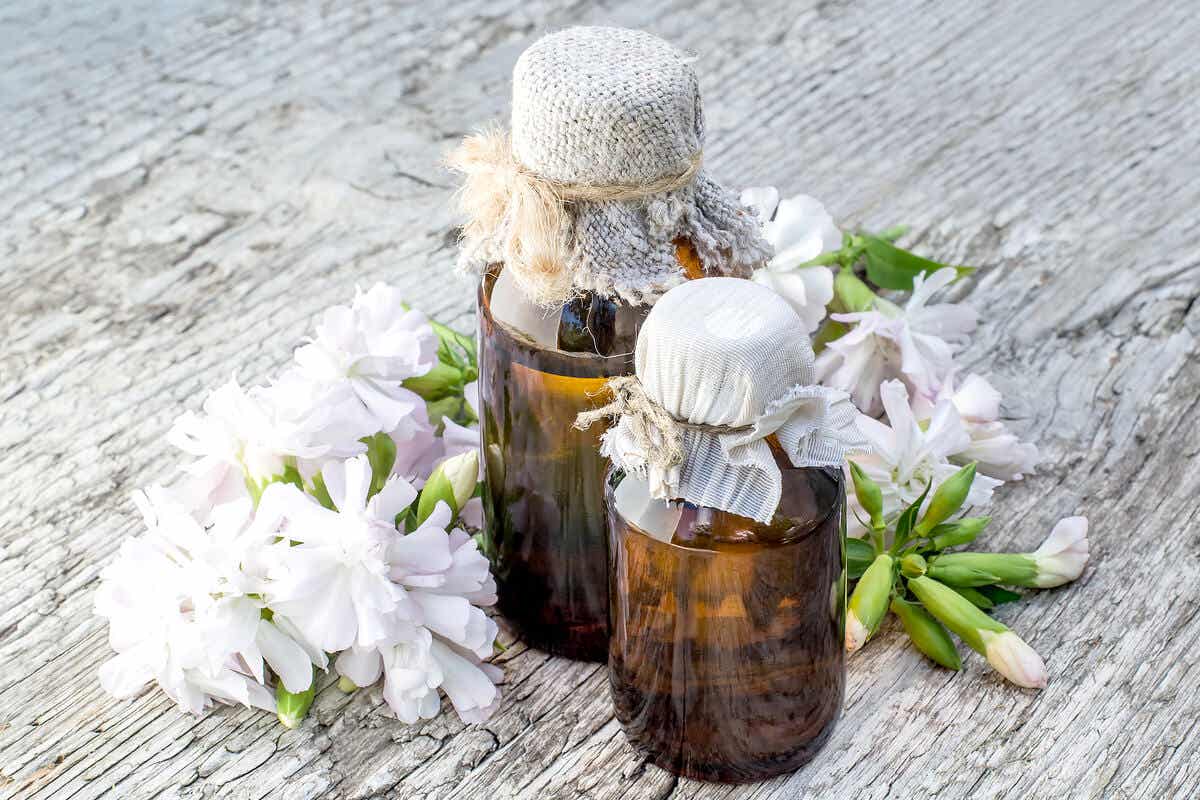The Properties and Medicinal Uses of Soapwort


Reviewed and approved by the pharmacist Franciele Rohor de Souza
Would you like to know more about the properties and medicinal uses of soapwort? If so, keep reading!
Soapwort, or Saponaria officinalis, is a plant native to southern and central Europe and Southeast Asia. Nowadays, it’s also cultivated in North America and a wide variety of other countries, where it’s used as a garden plant or for making cleansers and remedies.
In particular, soapwort’s a herbaceous perennial with rhizomes, an erect stem, lanceolate leaves, and flowers in shades of white, pink, or violet. It doesn’t usually exceed 24 inches in height and is generally easy to grow. It even has a high tolerance to drought and can grow in sandy soils.
According to an article that appeared in the Iranian Journal of Pharmaceutical Research, soapwort stands out for its high concentration of saponins, substances that give it the ability to form foam. Likewise, it’s said to have depurative, tonic, and expectorant qualities.
But what are its benefits?
The properties and medicinal uses of soapwort
The composition of soapwort includes substances such as saponins (up to 5%), flavonoids, sugars, resin, vitamin C, and small amounts of essential oil. Because of this, it’s not surprising that it’s said to have surfactant, anti-inflammatory, antioxidant, antiviral, antifungal, and expectorant properties.
Although there’s still limited evidence, some in vitro and animal studies support several of its effects. Of course, we should make it clear that it’s not a miracle remedy or anything of the sort.
It’s simply said to have potential as an adjuvant for some health-related issues. We’ll address these issues in greater detail below.

Candida albicans infection
Because of its potential as a natural antifungal, researchers have studied soapwort as a possible therapeutic agent against Candida albicans infections. In research that the Journal of Medical Microbiology reported, scientists used saponin-rich fractions from this plant alone and in combination with various antifungals.
The researchers found that, although this extract didn’t have direct antifungal activity, it did help inhibit germ tube and biofilm formation. In addition, it also demonstrated high cytotoxicity, which is a relevant immune response against infectious agents of this type.
Read also: Cutaneous Candidiasis: Five Treatments
Coughs and bronchitis
Soapwort is not a first-choice remedy for fighting bronchitis or coughs. Even so, in traditional medicine, people have used doses of 1 or 2 grams of extract of the herb to control these symptoms. For the same purpose, 1.5 grams daily of the root have been prescribed.
However, there’s a lack of evidence to corroborate its expectorant effects in humans.
Skin health
The saponins that this plant contains make it a natural cleanser that’s ideal for skincare. By producing foam and providing antioxidant, anti-inflammatory, and antimicrobial agents, it stimulates deep cleansing of the skin.
Therefore, it promotes the relief of conditions such as dermatitis, acne, and seborrhea. You can often find it in certain commercial cosmetic products.
Other potential benefits and uses of soapwort
- A study in Protein & Peptide Letters suggests that soapwort has anti-HIV effects that could have to do with its apoptosis-inducing activity and cytotoxic potential. Despite this, there’s no solid evidence to support its use as a therapy for this disease.
- Studies have also taken a look at the antitumor potential of this plant. In this regard, a review indicates that saporin-S6, a type 1 ribosome-inactivating protein, has provided interesting results when it comes to cancer therapy, especially in hematological tumors.
- Given its potential as an analgesic and anti-inflammatory, some also use soapwort as an adjunct to soothe pain resulting from rheumatism, gout, muscular disorders, and osteoarticular inflammations. However, as in the previous cases, the evidence on these uses of soapwort is scarce.
The risks and possible side effects
To date, there’s insufficient evidence to prove the safety and efficacy of soapwort. For now, we know that consuming it in high doses or for long periods causes hemolysis and severe irritation in the digestive tract. Therefore, it can lead to symptoms such as cramps, nausea, vomiting, and diarrhea.
Among other things, when it comes to its external use, we should practice caution, as it may cause irritation on sensitive skin or when it comes into contact with the eyes.
What’s more, pregnant and breastfeeding women should avoid its use. Finally, if you suffer from any underlying disease or if you’re undergoing drug treatment, you should consult your doctor before using soapwort.

How to use soapwort
There’s no clinical evidence to support a specific dosage of soapwort. In general, you should follow the recommendations on the product, whether in tea or extract. Don’t exceed 1.5 grams of dried soapwort for internal use.
In natural cleansers, it’s good to use 30 to 100 grams of rhizome per liter of water. Boil the mixture for 5 to 10 minutes and then let it stand for an hour.
Be sure to read: The 6 Best Medicinal Plants with Scientific Proof
What to remember about the properties and uses of soapwort
Due to its detergent effects, soapwort’s popular in the manufacture of cosmetic and household cleaners. Whats’ more, it’s said to possess certain medicinal properties.
However, many of these properties come from anecdotal data and there’s insufficient evidence to support them. Therefore, you should use it with caution, never overlooking the fact that it can be harmful if used in excess.
All cited sources were thoroughly reviewed by our team to ensure their quality, reliability, currency, and validity. The bibliography of this article was considered reliable and of academic or scientific accuracy.
- Sengul M, Ercisli S, Yildiz H, Gungor N, Kavaz A, Cetin B. Antioxidant, Antimicrobial Activity and Total Phenolic Content within the Aerial Parts of Artemisia absinthum, Artemisia santonicum and Saponaria officinalis. Iran J Pharm Res. 2011;10(1):49-56.
- Petrović GM, Ilić MD, Stankov-Jovanović VP, Stojanović GS, Jovanović SČ. Phytochemical analysis of Saponaria officinalis L. shoots and flowers essential oils. Nat Prod Res. 2018 Feb;32(3):331-334. doi: 10.1080/14786419.2017.1350668. Epub 2017 Jul 12. PMID: 28697622.
-
Sadowska B, Budzyńska A, Więckowska-Szakiel M, Paszkiewicz M, Stochmal A, Moniuszko-Szajwaj B, Kowalczyk M, Różalska B. New pharmacological properties of Medicago sativa and Saponaria officinalis saponin-rich fractions addressed to Candida albicans. J Med Microbiol. 2014 Aug;63(Pt 8):1076-1086. doi: 10.1099/jmm.0.075291-0. Epub 2014 May 21. PMID: 24850879.
- Blumenthal M, ed. The Complete German Commission E Monographs: Therapeutic Guide to Herbal Medicines. Austin, TX: American Botanical Council; 1998:209-210.
-
Jurek I, Góral I, Mierzyńska Z, Moniuszko-Szajwaj B, Wojciechowski K. Effect of synthetic surfactants and soapwort (Saponaria officinalis L.) extract on skin-mimetic model lipid monolayers. Biochim Biophys Acta Biomembr. 2019 Mar 1;1861(3):556-564. doi: 10.1016/j.bbamem.2018.12.005. Epub 2018 Dec 21. PMID: 30579962.
-
Polito L, Bortolotti M, Mercatelli D, Battelli MG, Bolognesi A. Saporin-S6: a useful tool in cancer therapy. Toxins (Basel). 2013 Oct 7;5(10):1698-722. doi: 10.3390/toxins5101698. PMID: 24105401; PMCID: PMC3813907.
This text is provided for informational purposes only and does not replace consultation with a professional. If in doubt, consult your specialist.








